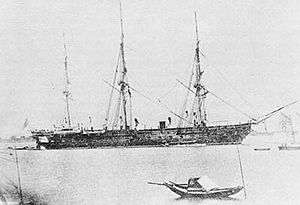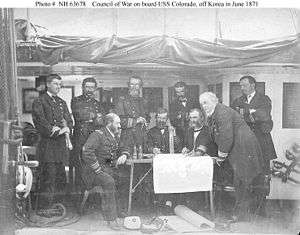USS Colorado (1856)
 USS Colorado | |
| History | |
|---|---|
| Builder: | Norfolk Navy Yard |
| Laid down: | 1856 |
| Launched: | 19 June 1856 |
| Sponsored by: | Ms. N. S. Dornin |
| Commissioned: | 13 March 1858 |
| Decommissioned: | 8 June 1876 |
| Fate: | Sold, 18 February 1885 |
| General characteristics | |
| Class and type: | none |
| Type: | Screw frigate |
| Displacement: | 3,425 long tons (3,480 t) |
| Length: | 263 ft 8 in (80.37 m) |
| Beam: | 52 ft 6 in (16.00 m) |
| Draft: | 22 ft 1 in (6.73 m) |
| Propulsion: | Steam engine |
| Sail plan: | Three masts |
| Speed: | 9 kn (10 mph; 17 km/h) |
| Complement: | 674 officers and men[1] |
| Armament: |
|
| General characteristics 1864 | |
| Class and type: | none |
| Armament: |
|
| General characteristics 1871 | |
| Class and type: | none |
| Armament: |
|
The first USS Colorado, a 3,400-long-ton (3,500 t), three-masted[2] steam screw frigate, was launched on 19 June 1856 by the Norfolk Navy Yard. It was sponsored by Ms. N. S. Dornin, and commissioned on 13 March 1858, Captain W. H. Gardner in command.
Pre-Civil War
Putting to sea from Boston on 12 May 1858, Colorado cruised in Cuban waters deterring the practice of search by British cruisers until 6 August, when she returned to Boston and was placed in ordinary until 1861.
Civil War
Colorado was recommissioned on 3 June 1861 and sailed from Boston on 18 June to join the Union Navy's Gulf Blockading Squadron, under the task force command of Commodore William Marvine's flagship for the Blockade.[2] On 14 September, an expedition under Lieutenant J. H. Russell from Colorado cut out the schooner Judah, believed to be preparing for service as a privateer and spiked one gun of a battery at the Pensacola Navy Yard, losing three men in the raid. On 11 December, another expedition was sent to Pilot Town and succeeded in capturing a small schooner and two men. Colorado assisted in the capture of the steamer Calhoun (or Cuba) on 23 January 1862 off South West Pass at the mouth of the Mississippi River, and a week later engaged four Confederate steamers.
In April 1862 the Colorado, built for fighting at sea, was prevented from participating in the Battle of New Orleans because her draft was too deep to cross the bar. Nineteen guns and one howitzer were removed and distributed across the fleet.[3] She returned to Boston on 21 June and was decommissioned from 28 June-10 November.
Colorado sailed from Portsmouth, New Hampshire on 9 December to rejoin the blockading force off Mobile, Alabama on 13 March 1863. She shared in the capture of the schooner Hunter on 17 May. Returning to Portsmouth Navy Yard on 4 February 1864, she was again placed out of commission from 18 February-1 September.
Clearing Portsmouth on 6 October, she joined the North Atlantic Blockading Squadron and cruised off the coast of North Carolina until 26 January 1865. Colorado participated in the bombardment and capture of Fort Fisher from 13–15 January. She was struck six times by enemy fire which killed one man and wounded two.
By late 1864, Wilmington, North Carolina was the only port left to the Confederacy. Its access to the sea was protected by Fort Fisher, at the mouth of the Cape Fear River.
A joint Army-Navy attack in December failed (the First Battle of Fort Fisher, 7–27 December 1864).[4]
A second attack came in January (the Second Battle of Fort Fisher, 13–15 January 1865). Colorado was engaged, and George Dewey played a key role in her success.
Colorado, being a wooden ship, was placed in the line outside the monitors and other armored vessels but got a full share of conflict. Toward the end of the second engagement, when matters were moving the right way, Admiral Porter signaled Thatcher to close in and silence a certain part of the works. As Colorado had already received considerable damage, her officers remonstrated. But Dewey, who, had now acquired marked tactical ability, was quick to see the advantage to be gained by the move and the work was taken in fifteen minutes. The New York Times, commenting upon this part of the action, spoke of it as "the most beautiful duel of the war". When Admiral Porter came to congratulate Commodore Thatcher the latter said generously: "You must thank Lieutenant Dewey, sir. It was his move." Nevertheless Thatcher was promoted to Rear Admiral. He tried to take Dewey with him as his fleet captain when he went to supersede Farragut at Mobile Bay. This was not permitted, but Dewey was promoted to lieutenant-commander.[4]
Prizes
| Date[1] | Prize Name[1] | Gross Proceeds | Costs and Expenses | Amount for Distribution | Where Adjudicated | Sent to 4th Auditor for Distribution | Vessels Entitled to Share |
|---|---|---|---|---|---|---|---|
| 13 Sep 1861 | Judith | destroyed [1] | |||||
| 6 May 1862 | Lewis Whitmore |
Post-Civil War

European Squadron
From 3 February-25 May 1865, Colorado was again out of commission at New York Navy Yard. Ordered to the European Squadron as flagship, she sailed on 11 June and cruised off England, Portugal, and Spain, and in the Mediterranean and Adriatic Seas until she departed Cherbourg on 23 July 1867 for New York where she was placed in ordinary from 7 September 1867-15 February 1870. During this period LCDR Dewey's next tour of duty was in 1867 and 1868 as executive officer onboard USS Colorado.
Asiatic Squadron
Colorado was flagship of the Asiatic Squadron. America had emerged from the Civil War and its foreign policy at the time was to rival the European powers (France, Russia and Britain) in their efforts to establish trade and spheres of influence in China, Japan and Korea.
Colorado cruised on the Asiatic Station from 9 April 1870-15 March 1873. As flagship for Rear Admiral John Rodgers' squadron, she carried the U.S. Minister (to China and Korea) on a diplomatic mission in April 1871.
On 1 June 1871, an unprovoked attack was made on two ships of the squadron by shore batteries from two Korean forts on the Salee River. When no explanation was offered, a punitive expedition known as the Sinmiyangyo was mounted that destroyed the forts and inflicted heavy casualties on the Koreans.
Clearing Hong Kong on 21 November 1872, Colorado sailed by way of Singapore and Cape Town for New York, arriving on 11 March 1873.
North Atlantic Squadron
Colorado sailed from New York on 12 December to cruise the North Atlantic Station, and became flagship of the North Atlantic Squadron on 27 August 1874.
Decommissioned
Returning to New York on 30 May 1876, Colorado was placed out of commission on 8 June. From 1876-1884, she was used as a Receiving Ship at New York Navy Yard. She was sold on 14 February 1885 to a private company; and broken up for salvage material and burned for her copper fastenings.[2]
See also
- List of steam frigates of the United States Navy
- Bibliography of early American naval history
- Union Navy
References
| Wikimedia Commons has media related to USS Colorado (ship, 1856). |
- This article incorporates text from the public domain Dictionary of American Naval Fighting Ships. The entry can be found here.
- Silverstone, Paul H. Warships of the Civil War Navies Naval Institute Press, Annapolis, MD, 1989, ISBN 0-87021-783-6.